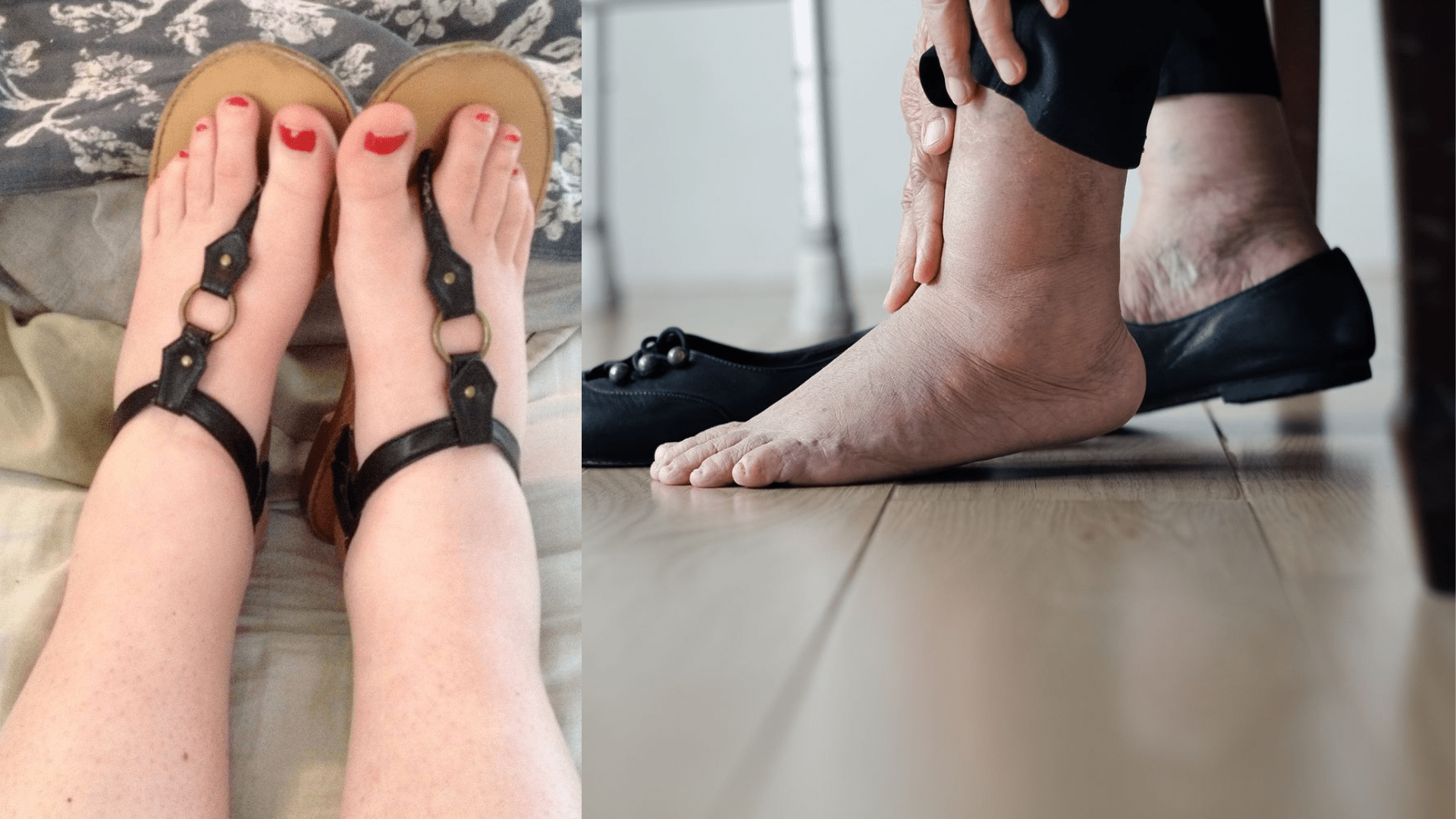Cankles refer to a visual lack of distinction between the calf and ankle, where the lower leg appears to have a uniform thickness without a defined narrowing at the ankle. This nonmedical term first emerged in 2001 and has since been used to describe ankles that are thick or wide, often due to a variety of causes ranging from genetic predisposition to lifestyle factors such as diet and exercise, or even underlying health conditions. While cankles are mostly a cosmetic concern for many, they can sometimes signal more serious health issues that may require attention.
Understanding Cankles
Definition: A Simple Explanation

Cankles are defined as wide or thick ankles that appear indistinguishable from the lower calf. This term, which is informal and not used in a medical context, describes the appearance of the lower leg where the transition between the calf and ankle is not clearly defined. Cankles can be a natural variation of leg shape, but they might also occur due to factors like weight gain, water retention, or certain health conditions. The term cankle itself combines the words “calf” and “ankle,” highlighting the area of concern where the calf seems to merge directly into the ankle without the typical narrowing.
The Anatomy Behind Cankles
Cankles occur when there is a lack of definition between the calves and ankles, leading to an appearance where the lower part of the calf seems to blend directly into the foot without a noticeable narrowing at the ankle. This can result from a variety of causes including genetic predisposition, obesity, fluid retention, or conditions that lead to swelling and changes in the distribution of fat and muscle in the leg. Factors such as diet, pregnancy, and injury can also contribute to the development of cankles by causing changes in the body’s fluid balance or the structure of tissues around the ankles.
The Causes of Cankles
Genetic Predisposition
Cankles, a term used to describe the appearance where the calf and ankle seem to merge without a defined tapering, can often be attributed to genetic factors. If you have family members with cankles, there’s a high likelihood that genetics play a significant role in your own experience with them. This genetic predisposition means that, despite efforts through diet or exercise, some individuals may naturally have less definition between their calves and ankles due to inherited traits concerning fat distribution, muscle structure, and bone shape.
Lifestyle Factors
Diet

Lifestyle factors, particularly diet, play a significant role in the development of cankles. Excessive body weight, often resulting from a sedentary lifestyle and an unhealthy diet, is a primary cause. This excess weight increases the strain on weight-bearing joints, including the ankles, which can lead to swelling and the appearance of cankles. High sodium intake is another dietary factor that contributes to cankles by promoting fluid retention in the body, exacerbating the swelling of ankles. Implementing dietary modifications to address these risk factors, such as reducing sodium intake and promoting a balanced, nutritious diet, can help manage and potentially reduce the appearance of cankles.
Exercise

Regular exercise can significantly help in reducing the appearance of cankles by toning the calf muscles and improving circulation. Effective exercises for targeting cankles include:
- Calf Raises: Perform standing calf raises, seated calf raises, and stair calf raises to strengthen and tone the calf muscles.
- Jumping Rope: This high-intensity cardiovascular exercise also helps tone your leg muscles, including the calves.
- High-Knee Jog In Place: Another excellent cardiovascular exercise that strengthens the lower body and improves circulation.
- Single-Leg Calf Raise: Focuses on each calf individually, ensuring balanced strength and tone.
- Plie Squat With Heel Raise: A variation that targets multiple leg muscles, including the calves.
Consistency with these exercises, along with maintaining a healthy diet and lifestyle, can aid in reducing cankles over time.
Health Conditions
Cankles, a term combining “calves” and “ankles,” refer to the appearance of thick or swollen ankles where the calf merges with what is typically a narrower ankle without a defined separation. Several health conditions and lifestyle factors can contribute to the development of cankles:
- Overweight and Obesity: Excess body weight can lead to fat deposits in various parts of the body, including the ankle area, contributing to the appearance of cankles.
- Fluid Retention: Factors such as hormonal changes, high sodium intake, and prolonged standing or sitting can cause fluid to accumulate in the lower legs, leading to swollen ankles.
- Genetics: In some cases, genetics can play a role in the structure and fat distribution of the lower legs, leading to a predisposition for cankles.
- Venous Insufficiency: Poor circulation and issues with the veins in the legs, such as varicose veins, can result in fluid buildup and swelling in the ankles.
- Lymphedema: A condition that causes swelling due to lymphatic system blockages can also contribute to the appearance of cankles.
Lifestyle changes, including weight management, regular exercise, and reducing sodium intake, can help address some of the underlying causes of cankles.
Why Cankles Are a Concern
Aesthetic Considerations
The concern over cankles primarily stems from aesthetic and societal beauty standards, which often emphasize slender ankles as a mark of physical attractiveness. A thin ankle is considered a standard of beauty in modern times, with ankles having very low fat content making any deviation from this perceived norm noticeable. The perception of one’s own body significantly influences self-worth and confidence, and societal views or potential partner preferences regarding physical traits like cankles can impact this perception. The creation of terms like “cankles” reflects how language and cultural standards shape our views on beauty and body image, often highlighting certain physical traits as undesirable or less attractive. This focus on specific body ideals can lead to unnecessary concern over benign, painless bodily variations, fostering a lucrative market aimed at correcting these so-called flaws.
Health Implications
Cankles, where the calf and ankle appear to merge as one, can be more than just an aesthetic concern; they may indicate underlying health issues. Possible causes include:
- Fluid Retention: Excessive salt intake or conditions like pregnancy can cause fluid to build up in the body’s tissues, leading to swelling in the feet and ankles.
- Poor Circulation: Prolonged sitting or standing can lead to poor blood flow, causing the legs to swell and contribute to the appearance of cankles.
- Health Conditions: Certain health conditions, such as obesity, lymphedema, and venous insufficiency, can also lead to the development of cankles by affecting the body’s ability to properly circulate fluids.
It’s important to note that while cankles can be a cosmetic concern for some, they can also signal the need for a medical evaluation to rule out or manage potential health issues.
How to Address Cankles
Lifestyle Changes
Diet Adjustments
To address cankles through diet and lifestyle changes, consider the following recommendations:
- Reduce Sodium Intake: Excessive salt can cause water retention, leading to swelling in the ankles and lower legs. Aim to reduce your sodium intake to mitigate this effect.
- Incorporate Lean Proteins and Whole Grains: Include lean protein sources (chicken, fish, tofu) and whole grains (brown rice, quinoa, whole wheat bread) in your diet. These foods can support overall health and may help in managing cankles by preventing obesity.
- Consume More Vegetables and Cut Back on Saturated Fat: A diet rich in vegetables and low in saturated fats can contribute to reducing body fat and potentially the appearance of cankles. Avoid foods high in saturated fats like cream, butter, and cheese.
- Maintain a Calorie Deficit if Necessary: If obesity is a contributing factor to your cankles, healthily reducing your daily calorie intake may help. Focus on creating a balanced diet that still provides essential nutrients.
Incorporating Exercise
To address cankles through exercise, consider incorporating the following activities into your routine:
- Weighted Calf Raises: Stand upright, feet shoulder-width apart, holding weights at your sides. Shift weight onto the balls of your feet and raise your heels off the ground. This exercise strengthens and tones the calves.
- Calf Raises: Simply performing calf raises without weights can also be effective. This helps strengthen and define the lower leg muscles, contributing to a reduction in the appearance of cankles.
- Ankle Circles and Jogging: Incorporate ankle circles to improve flexibility and jogging to enhance cardiovascular health and muscle tone. These activities can also aid in reducing swelling in the ankles.
- Plie Squat With Heel Raise and Resistance Band Ankle Exercises: These exercises target the calves and the surrounding muscles, offering a comprehensive approach to slimming down and toning cankles.
- Regular Exercise: General physical activity helps burn fat and tone leg muscles, contributing to a more defined ankle and calf area.
Medical Treatments
To address cankles, a combination of medical treatments and lifestyle changes may be considered:
- Cosmetic Procedures: For persistent cankles, liposuction or calf reduction surgery might be options to consider. These procedures remove excess fat from around the lower leg area, offering a more defined appearance.
- Minimally Invasive Procedures: The AirSculpt® CankCüre™ by Elite Body Sculpture is another option, providing a less invasive form of fat removal specifically designed for the ankle area.
- Congestive Heart Failure Management: If cankles are due to congestive heart failure, medical management might include diuretics to reduce fluid retention and vasodilators to relax the blood vessels.
- Lifestyle Changes: Elevating the legs, avoiding prolonged sitting or standing, and wearing compression stockings can help reduce swelling in the ankles, complementing medical treatments.
Surgical Options
Addressing cankles may involve both lifestyle changes and surgical options, depending on the underlying cause and the individual’s condition. Lifestyle changes, including adopting a balanced diet, regular exercise, and maintaining a stable weight, are fundamental. These measures can help in managing cankles by reducing fat and improving circulation. For cases where lifestyle changes do not yield the desired results, and there is significant discomfort or dissatisfaction with the appearance of the ankles, surgical options may be considered.
Surgical interventions could include liposuction, where micro-liposculpting techniques are employed to remove excess fat and define the calf and ankle area. In scenarios where fat deposits in the ankles are causing pain or hindering mobility, more extensive surgeries might be necessary to improve quality of life. It is crucial to consult with a healthcare professional to understand the most appropriate treatment options based on individual needs and health conditions.
Preventing Cankles
Proactive Measures
Preventing cankles involves a combination of lifestyle choices aimed at maintaining overall health and specific strategies to support lower leg and ankle health:
- Regular Exercise: Engage in activities that enhance circulation and muscle strength in the legs. Incorporating a variety of exercises, including walking, interval training, squats, and lunges can be beneficial.
- Healthy Eating: Opt for a balanced diet that supports maintaining a healthy weight and reduces the risk of conditions that can exacerbate cankles, such as obesity or fluid retention.
- Limit Alcohol and Quit Smoking: Avoid excessive alcohol consumption and quit smoking. Both habits can adversely affect circulation and overall health, contributing to the development of cankles.
- Regular Health Screenings: Engage in regular health check-ups to catch and address any underlying health issues that could contribute to cankles, such as chronic diseases or poor circulation.
Implementing these proactive measures can significantly reduce the risk of developing cankles by promoting good circulation, muscle strength, and overall health.
Conclusion
Cankles, while often a subject of jest, can be a point of genuine concern for many. Whether they’re a result of genetics, lifestyle, or underlying health issues, understanding what cankles are and how they can be addressed or prevented is the first step towards embracing or changing them.
Read also: What Are Truffles?
FAQs
Q. Are cankles harmful?
Most of the time, cankles are more of a cosmetic concern than a health threat. However, they can sometimes indicate underlying health issues that need attention.
Q. Can exercise reduce cankles?
Yes, regular exercise, particularly those targeting the lower body, can help improve circulation and reduce the appearance of cankles by toning the muscles and facilitating fluid movement.
Q. Are cankles genetic?
For many, cankles are indeed a genetic trait passed down through families. However, lifestyle and health conditions can also play a significant role.
Q. Can cankles go away with weight loss?
If the cankles are partly due to excess fat accumulation, then yes, weight loss might reduce their appearance. However, if they’re primarily caused by genetics or fluid retention, weight loss might not have as significant an impact.
Q. Is surgery a viable option for cankles?
Surgery, such as liposuction, is considered a viable option for those seeking a permanent solution to cankles and for whom other treatments have not been effective. However, it’s important to consult with a medical professional to understand the risks and benefits.




